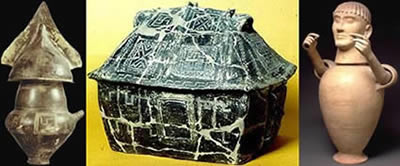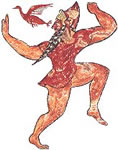|
In the eyes of their Greek
contemporaries and Roman successors, the Etruscans were clearly
a different ethnic group. Dionysus from Alycarnass said, "Not
only in the language, also for the way of life and for the
costumes, the Etruscans are different from all other populations."
Etruscan society was not centralized nor dominated by a single
leader or imperial city. The towns and hilltop villages of
Etruria appear to have enjoyed considerable sovereignty. However,
they did speak the same language, shared extremely similar
religious rituals, military practices, and social customs.
Religion dominated everyday life. The Etruscans believed that
among them existed an immutable course of divine will, and
their best intellectual efforts restlessly remained devoted
to the question and interpretation of destiny. Their gods
spoke to mortals through nature and all natural events: the
flight of birds, the sound of thunder, even the strikes of
lightning bolts. The Roman Philosopher Seneca summarized the
Etruscans’ beliefs:
"Whereas we (the Romans) believe lightning to be released as
a result of the collision of the clouds, they (the Etruscans) believe
that the clouds collide so as to release lightning, for as they
attribute all to the deity, they are led to believe not that things
have a meaning in so far as they occur, but rather that they occur
because they must have a meaning."
The Etruscan obsession with religion led to a preoccupation with
the dead and the other world thus inspiring their elaborate funerary
practices. (ArtLex; UPenn; Macnamara, 152-153; Bloch, 156)
Etruscans believed that death
was the journey to the afterlife and had a fear that the neglected
dead may become malevolent; therefore, tombs were constructed
with particular care, solidity, and lavishness. Thus, the
dead would take pleasure in their last dwelling, enjoy their
afterlife, and chose not to haunt the living. The Etruscans
were fond of decorating their sarcophagi with sculptures of
humans in natural poses. In particular, the Sarcophagus
of the Spouses depicts a couple lounging on a dining
couch. It is uncertain if it actually contained the joint
remains, but it idealizes the epitome of nuptial bliss. The
practice of cremation was quite common and decorative cinerary
or burial urns were often used to store remains. The styles
of urn range from biconical (vase shaped), to miniature hut
style to the canopic style with human figures or heads on
their lids. The sarcophagi and urns would be laid in the tomb
with other burial items necessary for the afterlife. (Adams,
198; Bloch, 157; Spivey, 92)

Biconical Urn ~ Hut Shapped Urn ~ Canopic Style Urn
Many tombs resembled houses and contained
furnishings and decorations, both real and reproduced in miniature.
The nearly intact Regolini-Galassi Tomb, discovered in
the necropolis of Etruria in 1837, is the most complete archeological
find from the "orientalizing" period of the Etruscan civilization
(late eighth to early sixth century B.C.). The tomb included jewelry,
pottery, a chariot, a nobleman's throne, and many other bronze and
gold artifacts. Sometimes the walls of tombs were frescoed with
scenes from daily life or the most important or enjoyable moments
in the deceased's life. The fresco from the Tomb of the Triclinium
shows banqueters reclining on couches while being entertained by
musicians and waited on by servants. Also depicted are many figures
of dancers and musicians playing together and a prowling Etruscan
cat on the hunt for morsels of food. Similarly, the Tomb of
the Lioness depicts themes of music, dancing and banqueting
also containing a crater that was likely used for the consumption
of wine. Both tombs’ frescoes illustrate the ubiquitous Etruscan
joie de vivre.
(ChristusRex.com; MysteriousEtruscans.com;
Spivey, 104)
|

Sarcophagus of the Spouses

Tomb of the Triclinium Fresco

Tomb of the Triclinium Fresco Detail

Tomb of the Lioness
 
Tomb of the Lioness Fresco Detail

You can try to take it with you...
|







